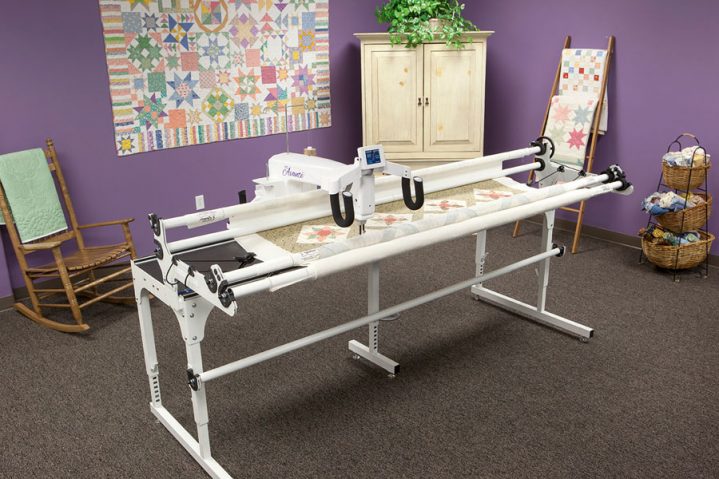
Mid and Longarm Machines with Anita Ellis
Do I need a longarm quilting machine? This is such a big decision, literally. Longarm quilting set-ups are big on space requirements and costly to purchase. Often these are the only things that are considered, but there is so much more to think about. As always, I am not going to advise you to buy this brand or that model. My aim is to direct you through your choices so that you can make the right one for you. First, you need to ask yourself some questions.
“Why am I considering purchasing a longarm quilting machine?” The answer will be different for everyone. Maybe you want to quilt your own quilts more quickly, extending your skill set, or are you considering a business quilting for others?
“Where am I on my quilting journey?” It doesn’t all have to come at once. Maybe you could start smaller and move up. Or maybe you are like me; I wanted to buy the best I could afford straight away.
“Am I prepared to invest the time and education to be a good longarm quilter?” I have spoken to too many people who have bought their lovely shiny machine and then been too scared to take it out of the box. Having a longarm quilting machine does not make you a quilter overnight. You need to add education into the mix too. Longarm quilters can charge a fair price for their work because it takes time to learn the relevant skills.
“Do I need to invest in one of the many computerised systems for my longarm machine?” This will bump up the spend even more and while it can be a good option for some, it isn’t the answer for everyone.
In my opinion, it is best to learn how to quilt on a hand-guided machine first and add the computer later. A computer robotic quilter will make your quilting easier and will be easier on your body, but do consider why you are thinking about making this purchase. I have stayed with the hand-guided machine as it suits my needs best. I love the organic form of free quilting.
Just because you have bought a computer-guided system doesn’t mean you press a button and set and forget. There is a steep learning curve here too — not just how to stitch the designs, but also where to put them. There are very few quilts that will not require you to do some freemotion quilting in the backgrounds behind motifs, or maybe stitch in the ditch when the seams are not perfect. Computerised systems, however, do excel at all-over (edge-to-edge) designs and can be good for a pantograph business set-up.
“How is my health?” Standing up at a machine can be taxing on your body. Some come with hydraulic height controls so that you can make adjustments for a more ergonomic working position. Others come with high saddle stools so that you can sit down to work.
“Do I have the money to make the purchase?” Do you need to borrow money to make the purchase? Factor interest and repayments into your sums. Are you lucky enough to have the cash to buy the machine outright? That is great, but you still need to be sure you are going to use it. They do take up a lot of space in your home.
With so many choices out there, it is useful to look at them by type, rather than brand or model. So what are the choices?
Full industrial longarm quilting machines with large throats, usually more than 20in.
Good solid options for a ‘work horse’ that will be with you for a long time. Not always as pretty as some consumer machines, but the advantage is that you can get to the parts that need servicing easily.

Consumer machines, aimed at the domestic market, in sizes varying from 15in upwards.
Often look great and come in various sizes to suit the space available. It is not usually possible to service these machines yourself, so access to a dealer network is important.

Learn Zentangle-inspired free-motion machine quilting!
Sit-down longarm and midarm machines.
A good option if you want to sit and quilt but want more space for your quilt than a domestic machine allows. These are often as costly as the bigger stand-up frames. The quilting movements will be the same as quilting on your domestic machine as you are moving the quilt, not the head of the machine, as you do with a frame-based set-up.

Quilting frames that will take a semi-industrial quilting machine, usually with a narrower throat.
- Often a less-expensive option.
- Narrow throat space limits design choices.
- This set-up is quickly outgrown.
- Quilting frames and domestic machines that need to be assembled and used on top of a regular table.
- Narrow throat space that limits design options.
- Inexpensive, but putting them up and down can be a very inconvenient process that often leads to under-use. (Think of the exercise machine that slides to fit under the bed … and gathers dust!)

Learn raw-edge machine appliqué, reverse appliqué and machine quilting
A decent throat space is important if you are going to gain an advantage over quilting on your domestic machine. Set-ups with narrower throat spaces will only allow for a small space of quilt to work on, whereas the larger machines will give you much more working area. This is also a consideration if you want to quilt pantograph designs with varying widths.
There is, however, such a thing as too much throat space. Our arms are only so long and accurate quilting will only happen when we are working in an area that is easily reached. If your arms are stretched too far you will lose control of the stitching and give yourself back problems too.
All longarm quilting set-ups come with one distinct advantage over a domestic machine; it is much easier to complete big sweeping designs on them. This is because you can make larger movements with your machine in a smoother manner. The other thing that longarm set-ups have over domestic machines is that the quilting is generally quicker, but that will depend on the style of quilting that you choose.
As a side note, it is usually much easier to do stitch in the ditch on domestic machines, so the advantages go both ways.
These are some considerations that apply to all types of set-up. When you are testing out machines, give yourself time to play with each one and consider these things:
Ergonomics Is the machine comfortable for me? You will be using the machine for hours at a time, so it needs to be adjustable to your needs.
Does the machine flow nicely? You don’t want to be fighting with the weight of it.
Does it fit? Sounds obvious, but do check your space to make sure it fits, with space to move around it. Depending on your choice, the machine may only need to be accessed from one end and the other end can be placed against a wall.
Stitching quality Does the stitch look good? Is it easy to adjust the length and use the stitch regulator? How easy it is to adjust the tension?
Machine set-up Does the price include machine set-up? What education is included in the price?
Picking your supplier I would recommend that you pick your supplier not just on the machine or price, but on the before- and after-sales service. It can be a steep learning curve and you want to know that someone will be there to guide you. Just because someone is a long way away doesn’t have to rule them out. The dealer for my machine is in another state and all I need to do is ring her up, put the phone near the machine, and she can usually diagnose the problem pretty quickly. Impressive, I think.
Back to that important question, price
So finally you have identified your quilting needs, chosen your supplier and machine type to suit those needs.
Do make sure you are comparing apples with apples when you are checking the prices of different machines. They will vary considerably according to what is included in the package. One brand may seem much cheaper than another, but then everything extra, such as the ruler base or pantograph laser, are added extras.
Don’t be in a hurry and get sucked into the first deal; check the small print or you might end up paying more than you thought. Most of all, enjoy your longarm. Don’t be one of those who leaves it in the box, too afraid to use it.


